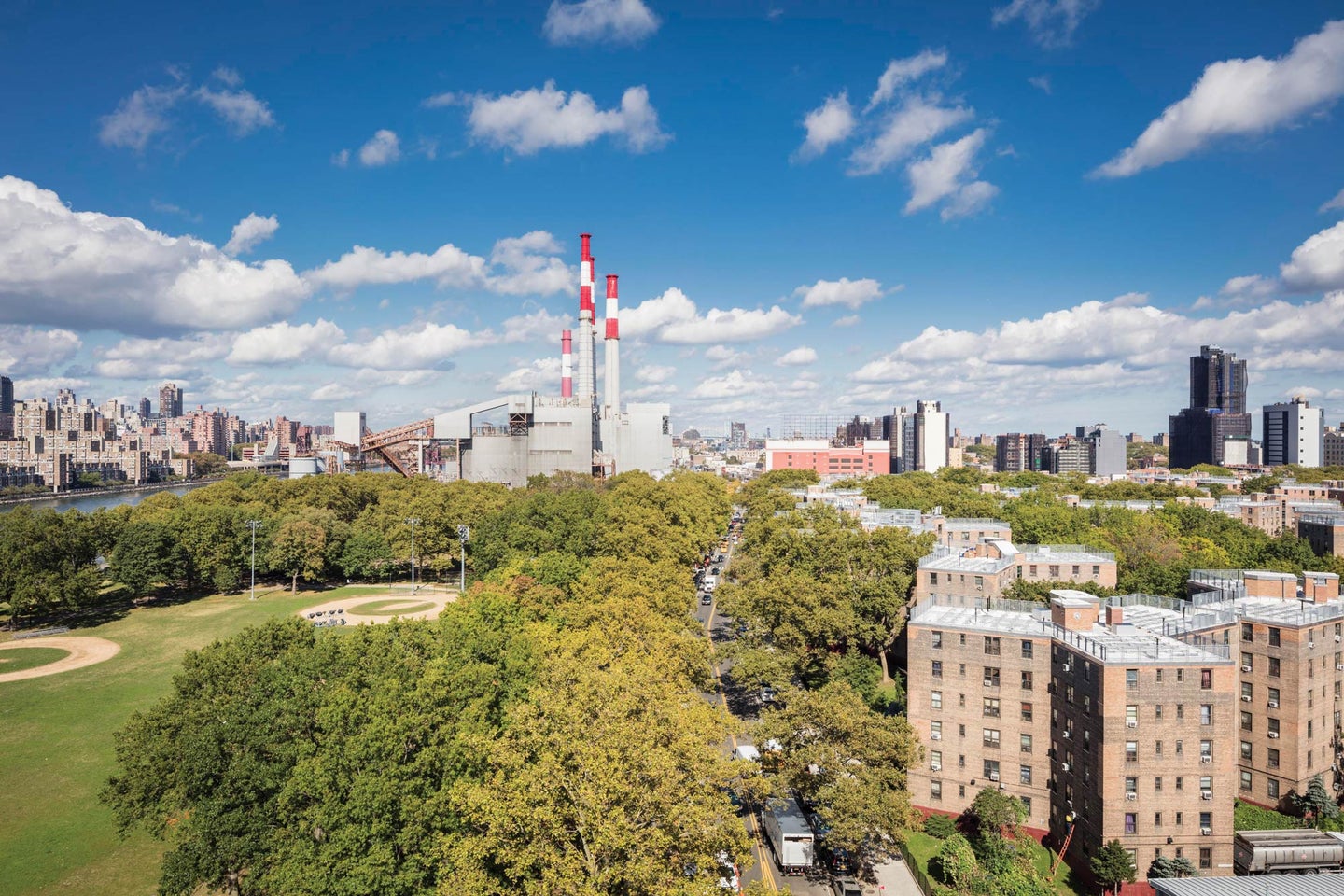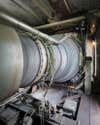At New York City’s biggest power plant, a switch to clean energy will help a neighborhood breathe easier
Aging, pollution-spilling equipment clocks its final days at the Ravenswood Generating Station.

When COVID-19 swept through New York City in the Spring of 2020, it did so unevenly. Hardest hit by far were communities of color, where the death rate was roughly double that of white neighborhoods. Overlapping constellations of reasons drove this—such areas house more essential workers, living in more crowded homes, with less access to health care—but among the more insidious was chronic exposure to air pollution. A nationwide study from the Harvard T. H. Chan School of Public Health found that COVID deaths increased by 8 percent with each additional microgram per cubic meter of fine particulate matter, the contaminant most closely linked to highways, truck traffic, and power plants. Given that the dirtiest and cleanest neighborhoods in New York City have an annual difference of about 4 micrograms per cubic meter, areas near heavy industries net a lot more deadly infections.
The residents of the Queensbridge Houses, the nation’s largest public housing project, worry this puts them at greater risk. “I’ve heard the conversation in the park over the last three months more than in the last five years,” says Suga Ray, a neighborhood activist and community builder. “People are talking about the plants over there,” he says of the Ravenswood Generating Station, whose iconic red-and-white-tipped smokestacks create an omnipresent frame for the skyline.
Queensbridge consists of 26 Y-shaped buildings in the shadow of the bridge that connects midtown Manhattan with the borough of Queens. Forty percent of its approximately 7,000 occupants live below the poverty line; 96 percent are nonwhite. Ravenswood, which can supply up to 20 percent of the city’s peak electricity needs, sits kitty-corner to these projects, and started generating power in 1963. The Queensbridge Houses opened in 1939. “That’s how you know it’s systemic,” Ray says. “They could have put it anywhere else. We create these structures in communities dominated by Black people.”
But in an American era defined by divisions and reckonings—both racial and environmental—Ravenswood is trying to clean up. That begins with its worst-offending units, the gas-fired plants known as “peakers,” turned on only to give the electric grid a boost on hot, or “peak,” days. The station can crank out some 2,050 megawatts of power (enough for around a million homes) in two ways. Four giant gas-and-oil-fueled steam turbines—ranging in age from 16 to 57 years—are its tortoises, ramping up slowly and deliberately, but always winning the race when it comes to total annual output. The hares are Ravenswood’s peakers, engines derived from the fuel-gulping jets on airliners, which, like similar systems around the United States, can spin up quickly to meet demand spikes. They don’t run often, but they run dirty. Most notably, according to the New York Department of Environmental Conservation (DEC), they emit nitrogen oxide at levels 30 times higher than cleaner turbines (like Ravenswood’s big tortoises). They emit it at the worst time: on hot, high-ozone days. And in the worst place: alongside communities of color, already filled with truck tailpipe emissions and the accompanying health impacts.

At the moments of highest demand, congestion on the grid means that electricity needs to be made near where it’s most needed—in cities. But can that happen more cleanly? In 2019, New York state passed one of the most ambitious climate laws in the country, mandating 100 percent carbon-free power by 2040. On top of that, the state DEC adopted a rule specifically targeting peakers, lowering their emission limits to a point that will force many into early retirement, Ravenswood’s included. Under the new legislation, the station’s three remaining units, all more than 50 years old and the last of an original fleet of 17, will be decommissioned by 2023.
In their place, Ravenswood’s owner—private equity firm LS Power—has received approval from New York state to build 316 megawatts of battery storage on-site, which will be among the largest such installations in the United States. The cells will physically and functionally take the place of the aging peakers, ultimately charging up with renewable energy from the grid and then dispatching it on the high-demand days. “The goal is to be able to maintain the same level of reliability that we have currently but with a lower level of emissions,” says Clint Plummer, CEO of Rise Light & Power, a new entity created to operate Ravenswood Generating Station as well as future projects. A former offshore wind executive, Plummer came on board in early 2020 with a mandate to redefine the high-profile plant as a paradigm of clean power, a key (and highly visible) node in the Empire State’s bold climate efforts. Legislation may have forced Ravenswood’s hand, but the generating station is leaning into its green transformation. (And LS Power expects the profits to follow.)
Ravenswood is not alone. Slowly but surely—like a supertanker being turned—giant batteries that leverage renewable power and redress long-standing environmental injustices are replacing aging, dirty, expensive-to-operate gas plants across the US. This summer, LS Power activated a 230-megawatt battery system near San Diego, adding it to a portfolio that already included a 40-megawatt unit nearby, making LS Power the largest grid storage operator in the country. But not for long. Its competitors have even bigger projects in the works, including a 400-megawatt system near Monterey Bay, California, and a 409-megawatt installation in Florida, adjacent to a 74.5-megawatt solar farm. Targeting peakers, often the dirtiest gas plants on the grid, gets at the low-hanging fruit; profit-driven power companies can check them off even as lithium-ion, the technology of today, remains relatively costly to implement.
What comes next for the grid will be harder. Energy providers will need to replace not merely the hares but also the tortoises, the large fossil-fueled plants that still supply around 60 percent of our electricity. Given that the greatest need for power will always be in places with the highest concentrations of people, and given that the facilities that exist in those areas are unjustly located in the most vulnerable communities, how can urban operators like Ravenswood achieve a low-carbon—and low–nitrogen oxide—future? Plummer intends to find out. “Our hope is that we can create a globally significant example of how to make this transition happen at a very practical, roll-up-your-sleeves, hands-in-the-mud, turning-wrenches perspective,” he says.
Ravenswood Generating Station is a three-block-long, approximately 27-acre rectangle hemmed in by a red-brick wall topped with razor wire. Shreds of snared plastic bags fleck the fence. Beside the entrance flies the company flag, a red R in the center of a black power-on circle laid against a white field stained gray by soot. Along with the Queensbridge Houses, the neighborhood holds a mix of taxi dealerships, ambulance repair shops, and old-fashioned lunch counters. A collision shop specializing in Teslas overflows with gleaming battery-propelled metal bodies that spill out across the broken sidewalk. On Ravenswood’s western flank, along the East River, barges arrive with their cargoes of fossil fuels, while even more comes in via pipeline, all stored in tall cylindrical tanks until it gets burned to charge up our laptops and keep our ice cream cold.
“The US electric system is a duck-billed platypus,” Plummer explains between sips of Muscle Milk during a videoconference call from his home office, where he is working during pandemic lockdown. “It is a highly evolved creature that involves a variety of very odd things coming together in one organism that is designed to do one thing really, really well: take fossil-fired generation and ensure reliability at the lowest cost.”

How and when that happens at Ravenswood is organized on a spreadsheet, seven rows tall by 24 columns wide, Plummer says. Each day, staffers send its data to the New York Independent System Operator (NYISO), the not-for-profit organization responsible for running the state’s grid. The columns indicate the hours of the day; the rows refer to the seven generating units on the site—the individual machines that make electricity, each of which has its own defining characteristics. The most famous among them is “Big Allis,” a 1,000-megawatt steam-powered plant named for Allis-Chalmers, the company that built it. Commissioned in 1965, it was for a time the largest steam turbine in the world. Alongside Big Allis, a smaller matched pair of steam generators also date from the 1960s, each producing approximately 400 megawatts, and a 2004 plant generates 250 megawatts using a state-of-the-art, relatively clean combined gas and steam system. The final three units are the peakers, active 50-somethings. Along with their already-decommissioned siblings, the peakers line up on the asphalt like mobile homes in a trailer park, each topped with a squat rectangular ventilation tower—a stovepipe hat. Rust peeks through their baby blue paint, while steampunk dials and old-fashioned corporate marques show their Apollo-era origins.
On Ravenswood’s spreadsheet, each box gets a dollar value: the bid to operate that one machine for that one hour, derived from the price of fuel and other calculations Plummer and his staff make to ensure their profit. The captains of the grid at NYISO then submit their order for the following day, working to carefully balance expected supply and demand for the 20 million people of the Empire State. The contract is crystal clear. The NYISO expects power plants to produce energy when the system operator calls on them, and we expect juice from the socket whenever we want it.
For it all to work, though, the grid needs peakers. To make sure it has them, Ravenswood and other New York stations collect “capacity payments” just for keeping their turbines on standby, as a kind of insurance policy for the days of highest demand. Between 2010 and 2019, those payments totaled nearly $1.2 billion to Ravenswood alone, according to an estimate by PEAK Coalition, a group of social justice and environmental organizations advocating to close the city’s peaker plants well ahead of the state’s 2040 deadline. That money, they say, could be better spent on clean technology. “It certainly doesn’t make sense that these ancient clunkers are getting paid these vast sums just to sit there,” says Rachel Spector, an environmental justice lawyer who worked on Dirty Energy, Big Money, the PEAK Coalition’s 2020 advocacy report.
Ravenswood is their poster child for what similar sites around the city must do. It won’t replace its last remaining peakers. Instead, the battery units proposed for the site will step into their role, topping off the city’s energy supply, but without the emissions. “So much of our electricity system is built for literally the worst possible hour of the hottest day of the decade—because you have to keep the lights on,” explains Ray Hohenstein, a director at Fluence, a battery technology company that was formed as a joint venture between infrastructure giants Siemens and AES. Fluence is the sort of company that might compete for Ravenswood’s project. The firm has worked on large installations around the world, and Hohenstein trumpets their transformative potential. “In networks of all kinds—food, commodities, data—storage is embedded in part to be a shock absorber between supply and demand,” he explains. With the arrival, at long last, of large, grid-connected batteries, “You can really start to manage that demand in ways that don’t require you to build infrastructure that’s hardly ever used.”
But limitations remain. As of now, the cells proposed by Rise Light & Power for Ravenswood are slated to be lithium-ion, the familiar technology already inside your phone and all those Teslas. At this point in time, the batteries that are similar in price to the peakers discharge all of their power in about four hours. But on days of peak demand, that won’t be enough. “Particularly in New York—and we expect in other densely populated urban areas— it’s highly likely that four hours is insufficient,” says Plummer. In order to provide electricity for longer and meet the grid’s requirements, Rise Light & Power will need to build two 316-megawatt systems that can run sequentially. But even getting that done will require approval from the Fire Department of the City of New York, which has so far eyed the volatility of large batteries warily. (A 2019 explosion at an installation in Arizona didn’t help matters any.)

Plummer is undeterred by the technology’s novelty. Before coming to Ravenswood, he worked for Ørsted, a Danish renewable energy giant in the midst of a big push to develop offshore wind in the waters off the East Coast of the United States, including an 880-megawatt deal with the New York Power Authority—an eye-popping scale by American standards. The enthusiasm of environment-minded state lawmakers has bolstered both projects. New York’s climate legislation mandates 3,000 megawatts of grid storage by 2030, making Ravenswood’s 316 a healthy bite. “The fact that the state wants to do this is something that we take very seriously,” Plummer says. His concern isn’t how to get it built technically or legally, but how to change the system as it exists now to ensure the plant’s future profits. Not for the first time, bold climate plans require modest financial risks.
The big batteries aren’t the first grand plan for Ravenswood. When the site was developed in the 1960s, engineers at the Consolidated Edison Company (ConEd) had their eye on the hot technology of their day: nuclear fission. In an application to the Atomic Energy Commission, ConEd proposed a million-kilowatt plant (about three times the size of the proposed batteries) across the street from a densely populated neighborhood two miles from Times Square. The city council introduced a bill prohibiting the construction of any atomic-powered generators, but the utility company pressed on. “Our faith in the future of nuclear power in the New York City area remains undiminished,” said Chairman Harland C. Forbes. The design was safe, the company claimed, insisting that its seven-foot-thick concrete shell could stand up to even a crashing airliner.
Today’s battery plan deserves a parade, it is so palatable in comparison. But the larger promise isn’t just a change in how we meet energy needs on peak days, but rather the gateway to a total rethinking of what urban plants like Ravenswood can do. The real challenge—and the big opportunity—is making the massive storage system not merely a replacement for the old peakers, but also the basis for the station to become a hub for the region’s transition to renewable power. Most notably, New York’s 2019 climate law calls for the installation of 9,000 megawatts of offshore wind farms by 2035, enough to satisfy roughly one-third of the state’s needs.
Wind is easy to bring ashore to the 8 million people in the Big Apple. Underwater cables can deliver electricity directly to Ravenswood’s prime riverfront real estate and already-jumbo grid connections—without having to traverse the region’s congested transmission lines. Marine surveys have already begun. And, just last month, the company announced plans to run one such high-megawatt cable that would funnel wind and solar power from Upstate New York to the city. The potential is a new kind of power station. Not merely a place where fossil fuel goes in and electricity comes out, but something more like a distribution center, with clean electrons coming in from wind turbines or solar panels, then stored on-site and dispatched according to needs.
Under that model, batteries can do much more than peakers ever could. They can help to “synchronize” the grid, ensuring that supply and demand are precisely equalized—which they can do by both collecting power and discharging it.
This story appears in the Winter 2020, Transformation issue of Popular Science.